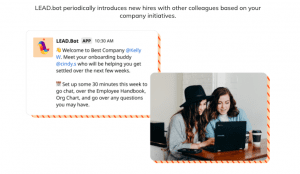In today’s modern workplace, despite the abundance of communication tools like email and Zoom, employees often feel disconnected from one another. To combat this isolation, it is crucial to foster a sense of community within your organization. One effective way to achieve this is by introducing various teams to each other, even if they don’t typically collaborate directly. And now, with LEAD.bot, the possibilities for cross-team matching have expanded even further.
LEAD.bot is a powerful tool that not only matches employees for engagement activities but also supports cross-team matches across different departments and roles. Imagine engineers having the opportunity to meet with project managers or engineers collaborating with the marketing team. These unexpected connections can greatly enhance your company’s culture, break down silos, and transform the work environment into a more fulfilling place.
Greater learning opportunities
At first, the idea of setting up additional meetings between teams might seem counterproductive, especially when time is already scarce. However, cross-team matching offers tremendous learning opportunities for your employees, ultimately increasing their engagement and retention within the company. By facilitating cross-team connections, you can create valuable career development paths and promote organic learning and growth without straining your resources or relying on external parties.
Consider the scenario where an engineer wonders what they could possibly learn from someone in sales. They may view themselves and the salesperson as mere colleagues who happen to work for the same organization, with different day-to-day responsibilities. The engineer may question how the salesperson’s insights could benefit their own work.
However, this limited perspective overlooks the wealth of knowledge and skills that can be exchanged between these two roles. Both parties can learn invaluable competencies from one another. The engineer can acquire effective presentation techniques, negotiation strategies, and communication skills, among other interpersonal abilities. On the other hand, the salesperson can gain knowledge in conducting product demos, managing customer expectations, explaining technical concepts in simple terms, and much more.
These examples merely scratch the surface of the potential benefits that can be achieved through cross-team matching. The strategy goes beyond pairing tech and non-tech individuals; it can connect teams across different branches or even between different global locations. For multinational companies, you can establish language-learning buddy programs or foster cultural and market awareness across teams based in New York and Los Angeles, Singapore and Tokyo, or any other combination.
By encouraging mentoring partnerships and cross-team collaboration, you foster a culture of continuous learning and development. When employees are provided with such professional growth opportunities, it sends a powerful message that your company is invested in their success and well-being. Notably, a comprehensive study conducted over seven years by the Harvard Business Review (HBR) found that these types of initiatives lead to increased employee retention and a more inclusive work environment.
With LEAD.bot’s support for cross-team matching, you can leverage the full potential of your organization’s talent and expertise. By breaking down barriers and promoting collaboration, you can nurture a thriving workplace where employees continuously learn from one another, fueling innovation and driving success.

Smashing Silos
While structure in a company is undeniably valuable, we need to recognize when this structure becomes constricting. An organizational silo is another word for a system that separates employees, such as departments or sections. While silos play an important role in keeping a company running, it’s also vital for employees to recognize they are all team members.
When silos go away, employees in different sections start to see other departments as enemies or rivals competing for budgets and other resources. The consequences range from unhealthy work environments to intra-department turf wars and even lower retention rates.
The best way to smash these silos is to emphasize a common goal and improve communications, according to Salesforce.com. With cross-team matching, managers can encourage teams that might be at odds to talk out their differences or just have them socialize. Cross-team matching can promote inclusivity and friendliness in daily action. Just the simple act of grabbing coffee or having a 15-minute check-in can encourage employees to see each other as team members, rather than as enemies.
Silos are good for structure, but not so much for socialization. When managers open lines of communication across departments, it reminds employees that they’re all on the same team. Connecting team members across departments help employees, especially new hires feel integrated into a team on both a personal and professional level.
Onboarding and mentoring programs

Introducing new hires and young professionals to buddies and mentors, and incorporating speed mentoring, can offer valuable opportunities for learning new aspects and gaining support. This is something our cross-matching function supports.
According to RecruiterBox, the younger generation, particularly millennials, highly value work environments that are mission-driven and collaborative. Companies recognize the significance of mentorship in shaping their employees’ experience and hold it as a determining factor for overall quality.
However, the importance of mentoring extends beyond just the younger workforce. Guider reveals that companies observe enhanced retention rates, increased employee engagement, and greater satisfaction when they implement effective mentorship programs.
Workplace mentoring fosters a sense of ownership among both mentors and mentees. Mentors play a vital role in their mentees’ professional development, leading them to become invested stakeholders in their mentees’ career growth. Conversely, mentees look up to their mentors as role models and appreciate having someone to listen to their concerns.
Moreover, mentoring programs serve as a platform for developing the competencies of all participants. The mentorship experience can be likened to an accelerated leadership development course, as mentors must refine problem-solving abilities, enhance communication skills, and provide constructive feedback.
Ultimately, the mentoring experience strengthens the connection employees feel with their workplace, benefiting both mentors and mentees. By introducing new hires and young professionals to buddies and mentors, and incorporating activities like speed mentoring, organizations can create a supportive environment that facilitates continuous learning and growth.
Using LEAD.bot
Ready to initiate team matching? LEAD, the company culture app, can assist you in this process. Not only does LEAD.bot enable you to introduce individual employees to one another, but it also facilitates team matching. With LEAD for Microsoft Teams, you can utilize the cross-team matching feature to foster interaction between entire groups of people within channels.
To begin, download the LEAD app for Microsoft Teams. Next, add LEAD.bot to the two Teams you wish to match, ensuring that you add the bot to Teams themselves and not different channels. Search for LEAD.bot in the apps section and add it to the desired Teams. Repeat this process for any other Teams you wish to include.
Once LEAD.bot is integrated into your Teams, type “dashboard” to engage with more advanced settings. Access your dashboard and navigate to the Matching Teams section (matching teams are those where LEAD.bot has been installed). Here, you can create a new Cross Matching configuration by following the on-screen instructions.
For instance, if you want to establish a mentorship program, assign all the mentors to one team and the mentees to another. Then, add LEAD.bot to both teams and access the dashboard. From there, you can select the mentor and mentees channels, customize their meeting schedules, and voila! Your mentorship program is set up with just a few clicks.
If you have any inquiries, comments, or concerns, please refer to our FAQ section at LEAD.app or reach out to us at hi@lead.app. We would be delighted to provide you with a demonstration or send you a tutorial link.
Additionally, LEAD is also compatible with Slack. To begin matching teams on Slack, install the LEAD app in your Slack workspace and follow similar steps as outlined above to configure team matching and set up your desired programs. For further assistance or information, please visit LEAD.app or contact us at hi@lead.app.








